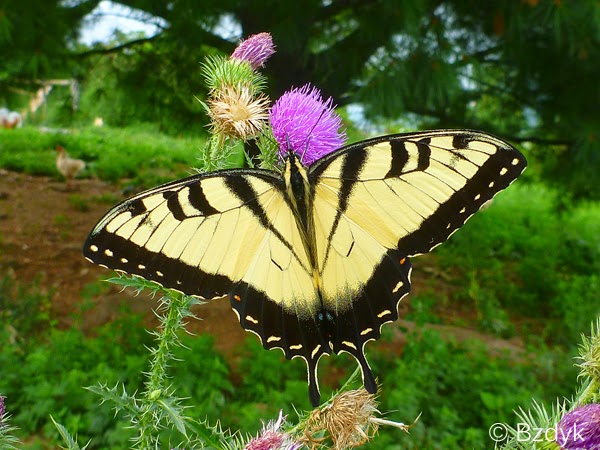The order Lepidoptera is fairly well known by people, because butterflies and moths are considered beautiful and appealing. Their life cycles are studied in school and many people know that caterpillars become butterflies. The monarch butterfly, which I'll write about later, is a special case of a migrating insect, and unfortunately are in decline due to habitat loss and pesticide use. The photos I did try to take of them - as they flew by on their way to Mexico - are not worth sharing, but I did see some.
The Zebra Swallowtail caterpillar Eurytides marcellus feeds on Paw-Paw. These adults were flitting about on a filed of clover, drinking nectar.
These tiger swallowtails Papilio glaucus were very cooperative and I managed to get a lot of good shots. They are seen feeding on thistle and the same feild of clover as the zebra swallowtails. The upper photo is a female, distinguished by the blue markings on the hindwings. Females can also be black. The lower photo shows a male, which are always yellow, and have a dark black area on the hindwing.
These photos are of the colorful Black Swallowtail caterpillar Papilio polyxenes on some dill. The caterpillar has a fun defensive technique of revealing two orange tentacle protrusions and producing a foul smell (that I couldn't detect) when disturbed.
While out on a walk I encountered this fuzzy Salt Marsh caterpillar Estigmene acrea. It was likely looking for a hiding place to pupate and overwinter.
This caterpillar is the common buckeye Junonia coenia. Note the metallic blue spines!
This interesting looking larva is a White-marked Tussock Moth caterpillar Orgyia leucostigma. These are known to cause allergic reactions so it's probably better to look and not touch.
This is the Banded Tussock Moth Halysidota tessellaris on a Japanese maple leaf. These caterpillars may also have irritating hairs.
I definitely have a soft spot for caterpillars, and spent many hours of my childhood searching for them and attempting to rear them. For an amausing story about one of those attempts, you should check out an article I wrote for the publication 'Habitat Herald'. My article appears near the end of the pdf: http://www.loudounwildlife.org/PDF_Files/Vol_19_Issue_2.pdf
And last but not least, here is Hemaris diffinis a hummingbird moth or Snowberry Clearwing.
This photo does not do this fascinating moth justice. It hovers gracefully around flowers, and is a mimic of bees and one I have worked with before. I happen to have three renderings (pencil, ink and wash) that I did in an undergraduate scientific illustration course, which attests to how much time I spent on this insect at one time. The pen and ink stippling alone took over 10 hours to complete!














1 comment:
Awesome.
Post a Comment